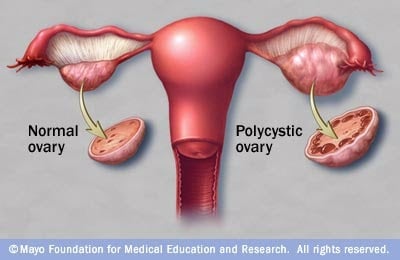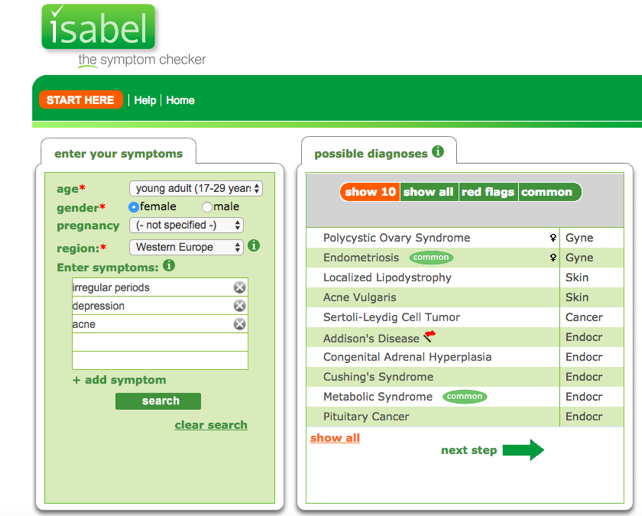- Privacy Policy
- Terms & Conditions
- Contact us
- ©Isabel Healthcare 2025
Polycystic Ovary Syndrome (PCOS) - New study shows delays in diagnosis
 In December 2016, a large international survey of 1,385 women, published in the Journal of Clinical Endocrinology and Metabolism, found that two thirds of women with polycystic ovary syndrome (PCOS) were dissatisfied with the length of time they waited and the number of healthcare professionals they had to see before they received a diagnosis. Nearly half of the women in the study saw three or more healthcare providers before they were diagnosed, and for a third of participants, the diagnostic process took more than two years to reach a final diagnosis. PCOS is notoriously difficult to diagnose, making it an often lengthy process, but there are a lot of symptoms to look out for and flag up in a consultation, as well as knowing who is most at risk of developing the condition. We’ve put together the symptoms and treatment information for the benefit of both patients and healthcare professionals, so you know what to spot when, and a diagnosis can be reached more efficiently.
In December 2016, a large international survey of 1,385 women, published in the Journal of Clinical Endocrinology and Metabolism, found that two thirds of women with polycystic ovary syndrome (PCOS) were dissatisfied with the length of time they waited and the number of healthcare professionals they had to see before they received a diagnosis. Nearly half of the women in the study saw three or more healthcare providers before they were diagnosed, and for a third of participants, the diagnostic process took more than two years to reach a final diagnosis. PCOS is notoriously difficult to diagnose, making it an often lengthy process, but there are a lot of symptoms to look out for and flag up in a consultation, as well as knowing who is most at risk of developing the condition. We’ve put together the symptoms and treatment information for the benefit of both patients and healthcare professionals, so you know what to spot when, and a diagnosis can be reached more efficiently.
What is PCOS?
PCOS occurs when a woman’s hormones are out of balance due to small cysts growing on the ovaries. It is a common disorder affecting between 9-18% of child bearing women and is a chronic disorder that impacts numerous aspects of a woman’s health across the metabolic, psychological and reproduction systems. A hormone imbalance can result in a large range of symptoms, including:
- Weight gain and inability to lose weight
- Extra hair on face and body, known as Hirsutism
- Irregular or heavy periods
- Acne
- Depression
- Infertility problems
The cause of PCOS is not fully understood but genetics seem to be a large factor. A diagnosis of PCOS is made when they have at least two of these three key features and other conditions have been ruled out:
- increased numbers of immature eggs in the ovaries seen on ultrasound (called polycystic ovaries)
- High levels of testosterone
- Irregular or absence of menstrual periods (amenorrhea)
Why is PCOS hard to diagnose?
It is interesting that a common, chronic disorder like PCOS, which affects so many women, can result in such a low number of patients expressing satisfaction with the diagnostic process. There is no single diagnostic test for PCOS, meaning it’s a diagnosis of exclusion and this can cause delays and frustration in both patient and doctor. Ensuring we are aware of the pitfalls surrounding PCOS diagnosis will allow us to reach a decision quicker, and the biggest thing we can learn from this study is that a thorough patient history, timely physical examination and good communication will all greatly improve the process. Both patient and healthcare provider then have all the information needed and can reach a diagnosis together.
Key diagnostic factors to consider include:
- Females of reproductive age – typically symptoms start at puberty. Be aware that if oral contraceptives were started at a young age that symptoms may be masked until therapy is stopped which may delay the presentation and diagnosis
- Irregular menstruation – short menstrual cycles of less than 21 days are a key symptom, as well as longer gaps between periods, or no periods at all
- Infertility - this could be the first symptom a patient experiences when trying to conceive, so PCOS should be kept in mind for patients looking for fertility treatments
- Hirsutism (excess hair growth) – this occurs in 60% of patients with PCOS. Many women use mechanical hair removal methods which may not be obvious during the physical exam, so be sure to enquire
- Acne – this may be masked by acne therapy, and could be exacerbated by other factors such as makeup or stress
- Weight gain – body mass and waist circumference should be measured in all women, as well as
Once the full history and physical exam are complete the health care provider will order several tests to check hormone levels, as well as ordering an ultrasound to check for ovarian cysts. Given the high incidence of insulin resistance and metabolic syndrome in PCOS, an oral glucose test and fasting lipid panel should be performed with all patients.
Visiting Different Specialists
In the survey from the Journal of Clinical Endocrinology and Metabolism, half of the participants revealed they had visited three or more healthcare providers during the diagnostic process. The diversity of the symptoms in patients with PCOS means they end up visiting many different medical specialists, ranging from a Dermatologist (acne), Endocrinologist (hirsutism), Gynecologist (fertility, irregular periods, amenorrhea) or even a Psychologist (depression). This takes up valuable time on both the patient’s and the specialists’ parts and makes it harder to coordinate care and communication, resulting in further delays in diagnosis. The specialist may also just treat the initial presenting symptom, for example acne treatment, rather than seeking further information from the patient. It is extremely important that the diversity of the symptoms is correlated and considered across all the body’s systems that have been affected.
One of the study’s authors, Helena Teede, FRACP, PhD of Monash University in Melbourne, Australia, stated the following and highlighted the need for a wider look not the diagnosis:
“Given the prevalence of PCOS, it is important for women and healthcare professionals to be more aware of the condition. Despite the misleading name, PCOS is not primarily an ovarian condition, but instead is a hormonal disturbance with diverse health effects that is largely inherited. The process of diagnosing PCOS needs to be improved, and the diverse set of metabolic, reproductive and psychological features need to be understood and addressed."
One way in which to ensure all the symptoms are considered is to use an online differential diagnosis tool like Isabel, which will help doctors to flag up all possibilities and know further questions to ask:

Isabel differential diagnosis generator considers various causes of the patient’s symptoms
For patients, we have the Isabel Symptom Checker which is based on the professional tool. This allows patients to search multiple symptoms and research the possibilities, which they can then discuss further with their healthcare provider. This is why it’s so important to put in all symptoms experienced, as seemingly unrelated symptoms could be linked.

Isabel Symptom Checker enables multiple symptoms to be considered
Treatment
PCOS is a chronic condition of which there is no cure. Management options are targeted at alleviating the signs and symptoms to reduce morbidity and the main goal of treatment is to prevent other complications occurring such as type 2 diabetes, metabolic syndrome, infertility or pregnancy related complications, including spontaneous pregnancy loss.
Therefore, the most important weapon to resolving symptoms and preventing complications arising is early diagnosis. Using differential diagnosis tools and symptom checkers can speed up diagnosis, save time, money and the development of potentially life threatening complications, which can easily be managed if a diagnosis is made soon enough.
You can use the Professional Isabel Ddx Generator and the Isabel Symptom Checker by clicking the buttons below:
Subscribe Here!
Recent Posts
Isabel DDx Companion with ChatGPT Integration - to help you diagnose even faster
At Isabel Healthcare, we’ve always been driven by one goal: to make clinical reasoning faster,..Virtual Triage: Do more questions lead to better patient outcomes?
One of the common misconceptions related to virtual triage / symptom checker tools is that the more..List Of Categories
- Differential Diagnosis Decision Support
- Differential diagnosis
- Symptom Checker
- Symptoms
- Medical Error
- Patient Disease Information
- Disease
- Clinical Decision Support
- Diagnostic Decision Support
- Isabel 1 Minute Read
- Diagnosis Error
- Diagnosis Skills Cases
- Healthcare Informatics
- Clinical Reasoning
- Evidence-based Medicine
- Medical Education
- Patient Engagement
- Symptom Triage
- Nurse Practitioner Education
- Nursing Decision Support
- Partnership
- Public Health
- COVID-19
- EHR
- Patient Empowerment
- Patient Safety
- rare disease

Start your FREE Trial today
Try the Isabel Pro DDx generator for 30-days - no payment card details required.





